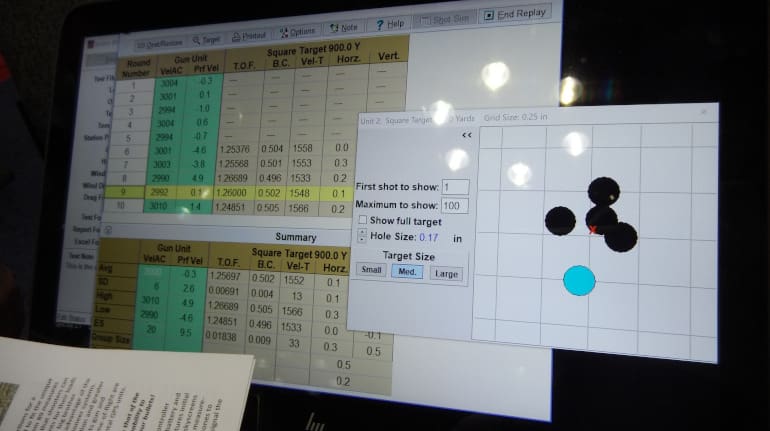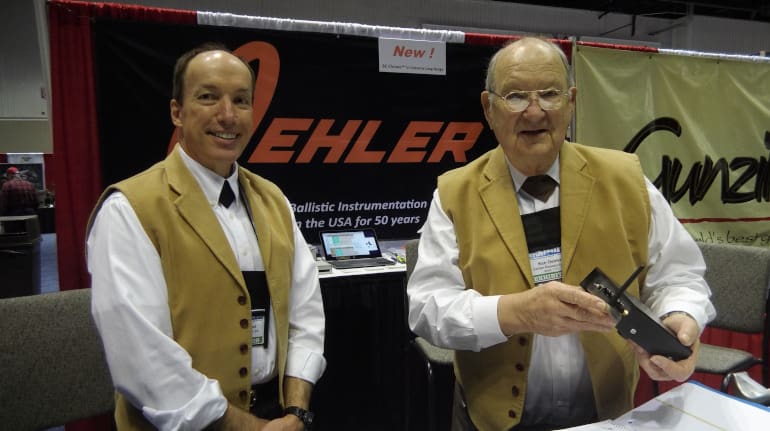
The Oehler Research booth at the NRA 2019 show was small and somewhat unassuming. I have to say that I was a bit disappointed that I did not see more of what I consider new and innovative products at this year’s NRA convention like I did at SHOT Show back in January, but that was until I stopped at Oehler.
I have used a Model 35P proof chronograph for the last couple years in my articles. It’s a great device that provides me with extremely accurate data and it is easy to use and set up. I have come to trust it and the results it gets.
When I stopped at the Oehler booth, it was more to simply shake hands with Dr. Oehler himself and put a face to the name. I was surprised to find that they had a new device that does some rather interesting things.

The BC Chrono System- also known as the System 89 Ballistic Coefficient Chronograph– is a multi-part machine that can determine the exact ballistic coefficient of your individual bullet.
Yes, you read that right. The system has the ability to determine the BC of a single fired round. For a long-range shooter, that’s amazing. In addition, it can also determine group size and muzzle velocity for a complete package of ballistic data.
The long-range shooter can take advantage of this because in one system they can test more variables and deliver better performance as a result. Imagine that you have a pet load that you’ve fine-tuned over the years, but you still can’t get it to do what you want at 900 yards despite the fact that you have it down to a standard deviation of 5fps.
Imagine now that you can analyze the bullets in flight. What if it turned out that your favorite brand of bullet had a widely varying ballistic coefficient at your chosen range? This type of data allows you to determine the exact flight characteristics of your bullets in flight.

So how much does this system cost? The answer is both higher and lower than you might expect at $2485. That’s a big chunk of change for the casual marksman, but for a person who spends $10,000 on optics, spotting scopes, barrels, actions, and other accessories, it’s a relative drop in the pond. The ability to test so many things with one machine has a great value of its own.
For more information, go to www.oehler-research.com to see full details.




Does this mean that an individual with an idea and a lathe can experiment and potentially come up with something innovative in projectile design?
Geoff PR,
I have been wondering for a long time, what does the “PR” in your name stand for? I always read that as Puerto Rico. Care to share?
An individual could do that even without this device.
Walked right by their booth at the NRA2019 in Indy on Sunday.. Nothing to announce anything new over the tried and true single point 35. Poor marketing. If that new unit is of the Doppler radar design, I would have been interested in learning more toward making a purchasing decision.
It’s not doppler. They combine their optical chrony for muzzle velocity with their sonic target scoring system. The target scoring system tells the impact time, which combined with muzzle velocity and time of firing, can derive the BC.
The Labradar is a radar doppler. It does have limitations based on bullet diameter, so measuring beyond 50 yards is difficult with. 22 bullets, or 100 yards with a .30. The comparisons I’ve seen some say the results are in line with the professional systems costing tens of thousands, but I can’t compare. It can be finicky outdoors if the terrain or background isn’t right, but I’ve had good results indoors and on flat ranged. I think there was TTAG review a few weeks ago. Bryan Litz trusts it enough that it’s a recommended product at Applied Ballistics
The Oehler setup can have the target at 10km, but it’s still sampling initial velocity at 1point near the barrel. The automatic target reporting can be nice if you’re shooting that far, but I’m fine with spotting scopes and pulling targets. I’m not saying Oehler is bad, but a middle class hobbyist without a private range has better options available.
Anymouse,
One person’s review on YouTube said that he has had trouble getting Doppler velocity readings past 50 yards with .30 caliber bullets. I might venture to guess that you would be limited to 15 yards with BBs or maybe 25 yards with a .22 caliber bullet?
Having thought about this further, I realized that people use Doppler radar guns to measure the velocity of baseballs when pitchers throw them. While baseballs are physically large, they cannot be all that reflective since they are made of organic materials rather than metallic materials. In fact I can even imagine that baseballs are radar absorptive. And yet radar guns seem to be able to measure them just fine.
This tells me that radar guns are immensely more sensitive than I imagined.
For reference here is the YouTube video where the reviewer mentions experiencing some trouble getting velocity on .30 caliber bullets past 50 yards:
https://www.youtube.com/watch?v=iGz3Gbf5njw
I was wrong. No TTAG review. It was an old TFB review comparing to Weibel that I only saw a couple weeks ago.
Besides terrain limitations, you need to aim the radar at the target, but they only give you a 1 inch groove to sight with. A boat tail bullet might cut down the effective caliber since the flat portion of the base that reflects well is smaller.
Oehler is good, but it’s old tech. Labradar does BC calculations with velocity sampling at multiple distances and doesn’t require equipment downrange. Oh, and it’s $1800 cheaper.
Anymouse,
How would you measure the velocity of a projectile at multiple distances downrange without any equipment downrange?
And if someone is going to claim Doppler radar, I want to see such a system in action because I have a very hard time imagining that the tiny back side of a bullet reflects enough energy for the radar gun to reliably determine velocity.
Sorry, the reply got posted to the thread above and I didn’t click the edit boxes.
I use a LabRadar with 22LR pretty regularly. The LabRadar stores an Excel spreadsheet that gives you an overview of each shot series. Then in a subfolder there are Excel spreadsheets for each individual shot in the series which provides details (velocity, distance, SNR) for the round every .002 seconds until the LabRadar can’t pick it up anymore. The SNR (signal-to-noise ratio) gives you a good indicator as to how reliable the data is at the different ranges. It’s not uncommon for the LabRadar to pickup a 22LR out to 100 yards. I also have about a 10% failure rate on 22LR where the SNR shows questionable data or (more commonly) the shot isn’t even picked up by the LabRadar. Missed shots are often caused by not having the LabRadar aimed at the target correctly. Moving up to a larger diameter bullet from a 22LR *significantly* increases the reliability of the LabRadar data.
While the LabRadar does not calculate BC, using the data from it and a Kestrel I can put the numbers into a ballistic calculator and get a BC per round which is then averaged to get a BC value that is usable is the Kestrel. I’ve found that the calculated BC is considerably more precise than the published BCs I’ve found online.
Remember that each bullet manufacturer uses their own system for determining the BC of their bullets. So the best that any comparison can ever be done on published BCs is comparing the various bullets made by one manufacturer against the others made by that same manufacturer.
Efforts to compare Nosler bullets to Sierras, or Barnes or Hornady, or any other two makers, by published BCs are doomed to failure. They’re all using(probably similar) but still different, scales.
Wrong. BC calculations made over 100 yards (the max Labradar range) are completely worthless. The 89 will measure time of flight to 2 miles and provide BC data relative to that distance.
Comments are closed.